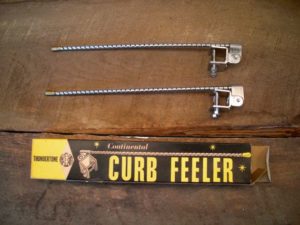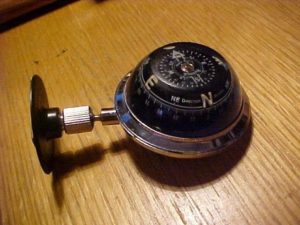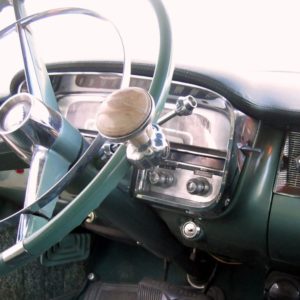
Today’s I remember JFK remembrance is the result of a conversation which took place between a coworker and myself earlier this week.
My buddy John Sorrells walked in, threw an object on my desk, and said “okay, nostalgia expert, what’s this?”
Without hesitation I said “Why, that’s a curb feeler.” John was impressed, but hey, I AM the nostalgia expert.
Curb feelers made their debut sometime in the early 50’s as an accessory added to luxury cars by Detroit. However, they were inexpensive add-ons for anyone who wanted to protect their tires from the unforgiving concrete that made up street curbs. This was particularly the case if one had big whitewalls on their sweet ride.
Whitewall tires weren’t really invented in as much as they were simply the original tires. In the automobile’s heyday of the Model T, tires were made of light-colored rubber. The rubber didn’t wear so well, so eventually, more carbon black was added to the tread area. This made for tires which were black around the circumference, but white on the sidewalls. As the entire tire began to be manufactured out of higher carbon-black rubber, consumers clamored for the look of their father’s tires. Thus, sidewalls were pigmented with a wide white stripe.
As the 50’s became the 60’s, the size of the whitewall began to shrink. By 1969, it was a narrow strip perhaps 1/2″ wide, often accompanied by a similar-sized red strip. Nowadays, of course, the whitewall is nearly extinct, as are so many of the things we remember.

Another disappearing accessory our fathers might have favored was the dashboard compass. Ever the focused navigators, our fathers wanted to know which way true north was. Perhaps they may have navigated B-24’s a few years earlier. Whatever the case, many a roomy sedan had a floating spherical compass mounted securely on the dash.
A 1954 ad had this to say about the trusty device: You can count on this pretested instrument, used by the armed forces, to tell you exactly where you’re headed. Used in the car, it’s a dependable companion for any motorist. Attaches with suction cup to dash or windshield. No getting lost with one of these predecessors to the GPS!
Another accessory our fathers may have preferred was the exterior window shades that kept the sun at bay.
My own father had a brand-new 1974 Audi and obtained his shades straight from the dealership. Made of shiny chrome, they clipped inside the topmost groove that contained the window. They might not have blocked a tremendous amount of sun, but look sharp they did.
Another accessory frequently spotted in Impalas and Fury’s of the 60’s was a console organizer designed to sit on the hump between the driver and passenger in front of the bench seat. The ones I remember had heavy bean bag “wings” that draped over the hump, with a box of sorts anchored to the top, where you could store drinks, road maps, ice scrapers, or any other gewgaws small enough to fit. There was a tremendous amount of unused room up there that the organizer put

to good use. in fact, I may have been able to fit my gorgeous little 1992 Tercel that I drive to work into one of those puppies!
My dad never had a steering wheel knob, but I can recall more than one pickup of my childhood sporting them. Why pickups? I don’t know. I’ll bet many of you recall them attached to steering wheels of basic four-door land boats, but I remember spotting two or three, all in 1950’s-era Ford and Chevy pickups. Perhaps they were a factory accessory? I’m not sure. All I know is that one could really whip a steering wheel back and forth with one of those gizmos.
My own dad was obsessed with gas mileage long before the fuel crisis, and thus purchased many an attachment designed to get the very last foot out of a gallon of gas. I remember one weird device called a “Pacer Magnum” that was designed to sit on an eight-cylinder distributor cap. It consisted of little cylinders about two inches long that plugged into the holes on the distributor, and were hollow on top so the spark plugs could plug into them. There were joined together by a wire, making the whole thing look like a string of firecrackers. Did it increase mileage? Apparently not. He never bought another one.
Our fathers loved their cars. I’m sure I’ve only scratched the surface of accessories that were lavished upon them. So how about you, readers? What little extras can you recall that your own parents purchasing to trick out their rides?
Steering wheel knobs were not factory items, but rather an accessory added to automobiles to aid in parking cars and trucks, before the almost universal appearance of power steering.
Older automobiles, especially trucks often had a 6-8 turn lock to lock travel on the steering mechanism.
The steering knob (Often purchased from J.C. Whitney, another boomer item which has disappeared)
allowed a quicker cranking of the steering wheel, and thusly, parallel parking. (One more thing which has disappeared.)